Recipe schemes for pizzeria cuisine. Process, testing, instructions to the schemes
In the last post I described the process of creating recipe schemes for pizzerias. In the same place I promised to tell about the process of work and testing.
So, my task was to graphically depict pizza recipes, come up with universal schemes for the number of ingredients in each pizza, and the main thing is to make all this understandable for the average employee of the pizzeria.
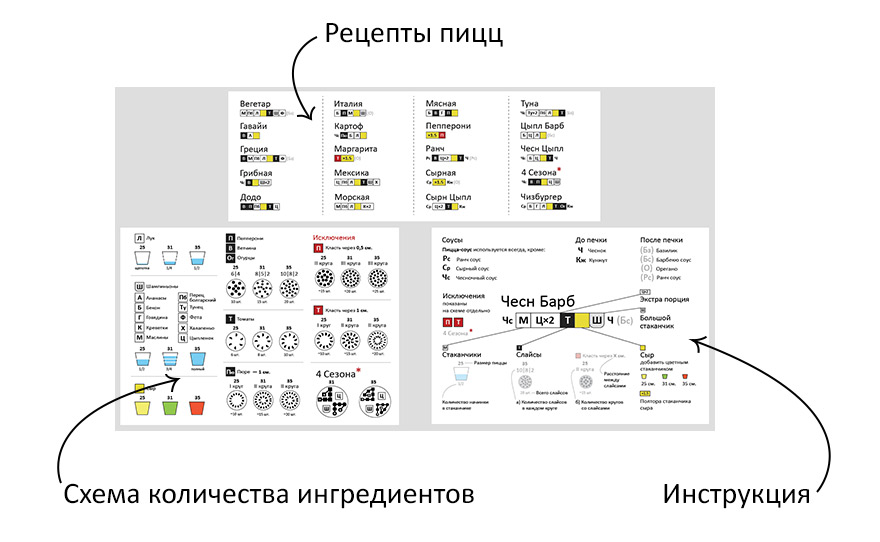
One of the intermediate versions of a set of schemes for pizzerias. Schemes placed in this way were deployed on a monitor during testing before a volunteer. Today, in pizzerias, the ratio of the scale of the sizes of the schemes is different.
To understand the problem, I will give an example of the process of making Hawaiian pizza. If the name of this pizza is highlighted on the screen of the pizza player, he will find instructions on how to make it.

')
The employee will add 15 pieces of ham slices in 3 circles, a double portion of pineapples (3/4 cups two times) and a standard portion of Mozzarella cheese for an average pizza (1 full green cup - the colors of the cups are not random, we have green boxes for medium pizzas) ).
The design has come a long way to the final version. Many of the change decisions are made as a result of testing on people who have never been to a pizzeria in the kitchen.
Simultaneously with the design of the schemes, the design of the instructions was also tested, which should have explained to the person the principle of the schemes themselves.
Testing has passed two stages.
At the first stage, I simply showed the results in the form of a PDF to managers and experienced employees of the pizzeria. Here we have identified the most obvious problems and difficulties.
At the second stage, I was looking for “people from the street,” that is, those who did not even work in a company, not like cooking pizza at a pizzeria. They were friends of acquaintances, office staff, casual visitors to a pizzeria, and even a course teacher for company managers. They showed the scheme, but I did not have access to the kitchen. I had to come up with a simulation.
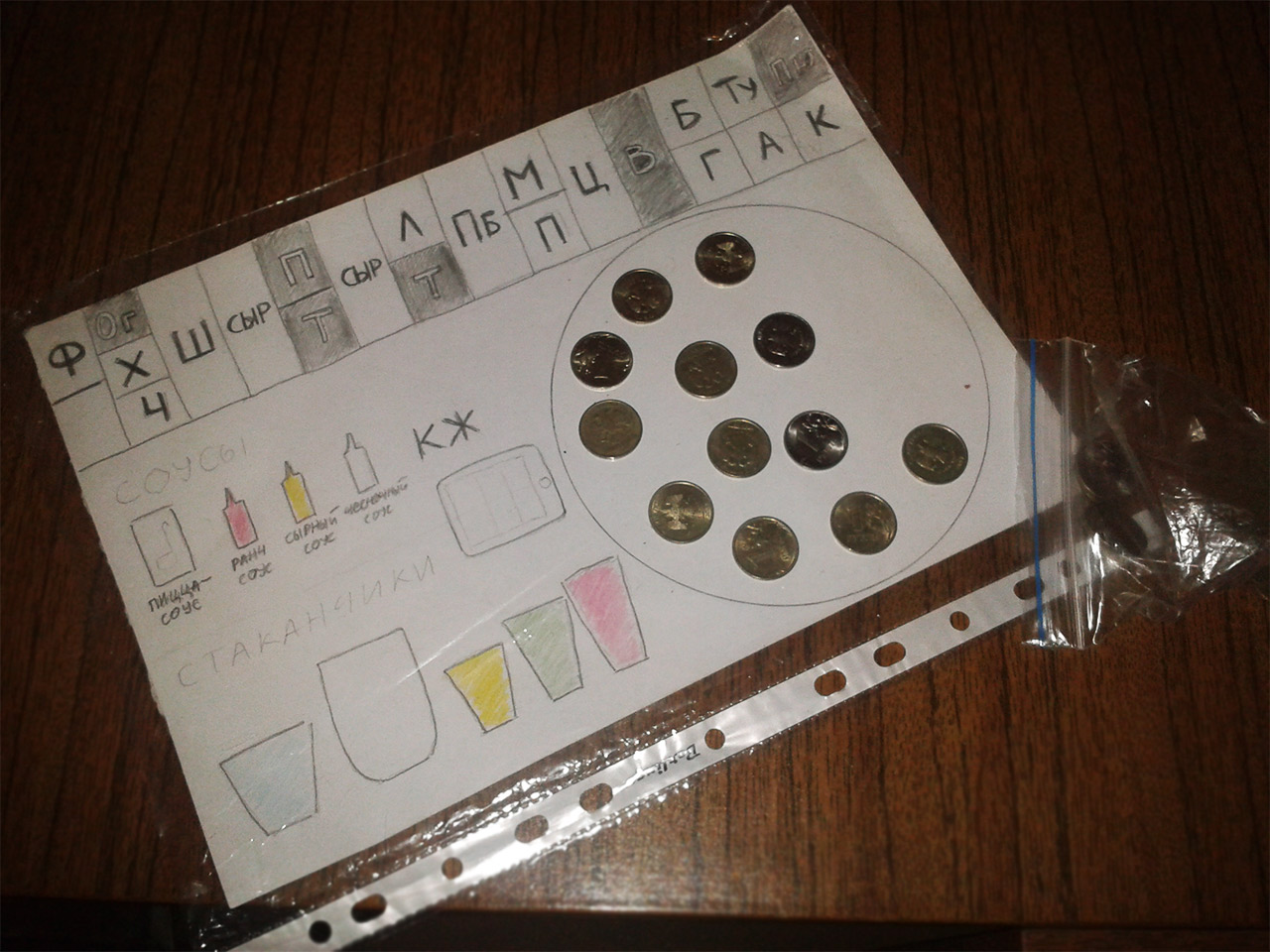
"Layout" of the pizza assembly line on A4 paper
A computer with unfolded diagrams was placed in front of the subject, and an A4 sheet and several coins were placed on the table in front of him. I asked to comment out loud the process of reading the diagrams and watched how the person spreads the coin slices inside the drawn circle and what sequence different cups use.
After each stage of testing, I redraw the schema and start looking for new subjects for tests - retesting on the same people did not make much sense. It was possible to test the scheme on a few dozen people.
Some of the details varied precisely because I saw difficulties in understanding the schemes of people. Then I will describe some of these changes - perhaps the information will be useful for someone.

An attempt to introduce an abstract designation of cups failed - the cup icon read better. For the bow, a suggestion was made to draw a pinch with a special icon. Here it is possible to trace how the placement of the signature changed with the number on the charts. As a result, all the inscriptions were centered.

To avoid visual noise, it was planned to show columns with dimensions at the very top of the diagram. Due to difficulties in reading the diagrams, the sizes were duplicated for each block. You can also pay attention to how the blocks were separated from each other by rulers.

It was originally planned to make a separate "legend" for the reduction of ingredients. But it turned out to be much more convenient to read the abbreviations combined with the transcripts. At first, the blocks of abbreviations had to be placed compactly in a limited space, but in the final version of the place it turned out to be allocated enough and all the abbreviations lined up in a column - it is easier to find and read them on the diagram.

All the ingredients in the diagrams are divided into those that are put into cups and those that are put into slices (chopped by the ingredients). The headlines of the groups were first simply written in text, then there was an attempt to completely remove the headings, but in the end, the headings were decorated in the same style as the ingredients in the corresponding group.
It was immediately clear that all pizza recipes with the same amount of ingredients could not be adjusted - you need to provide for exceptions.
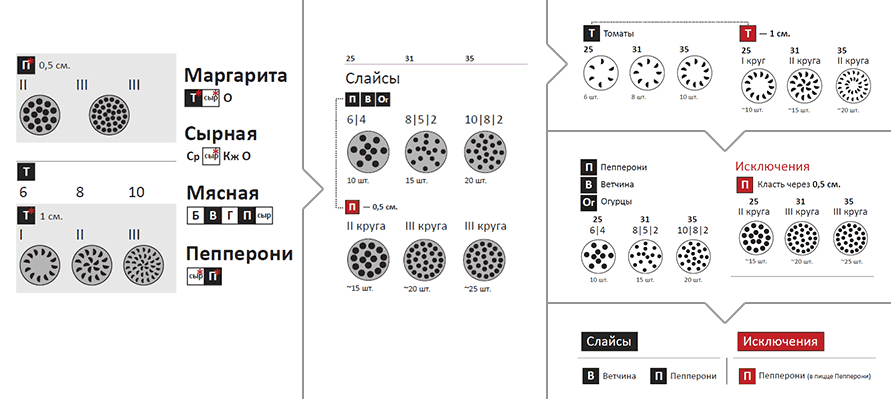
At first there were attempts to single out an exception with an asterisk in the recipe and, with an asterisk, to show the exception scheme under the normal scheme. But this is too imperceptible. Then the whole block of ingredient reduction-exception is highlighted in red background color. But in the quantity scheme there are attempts to somehow combine the normal quantity of the ingredient with the quantity in the exception (dashed line). As a result, all exceptions are placed in a separate column and receive the appropriate header.
A separate story with a pizza recipe Four seasons.

Slices of ham and pepperoni should be laid out with a “triangle”, and cups of champignons and chicken each in their own quarter pizza.
One of the most difficult problems was to convey to the pizza maker the principle of slicing.
The fact is that the slices are laid out in two ways: individually (possibly with a different number of circles for different sizes of pizzas) or at a certain distance from each other (in this case it is not necessary to count the slices). Recipes-exceptions are often based on the second version of the layout.
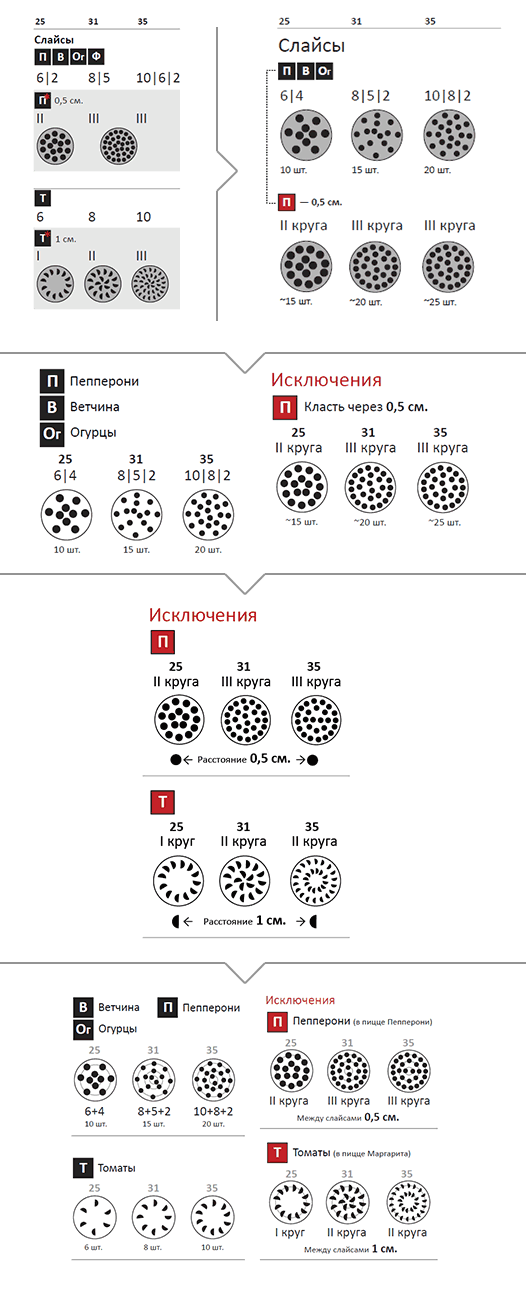
At first, an approximate number of slices was indicated even in cases of exceptions (~ 15 and so on), but the person who noticed a specific number departed from the principle of calculation at a specified distance. For circles, it was decided to show the “guides”, otherwise the circles on the diagram were read poorly. In addition, it turned out that the amount of ingredient in each circle is better indicated by plus (“8 | 5 | 2” turned into “8 + 5 + 2”). It is also interesting to follow how the wording and design of the instruction about the distances between the slices changed.
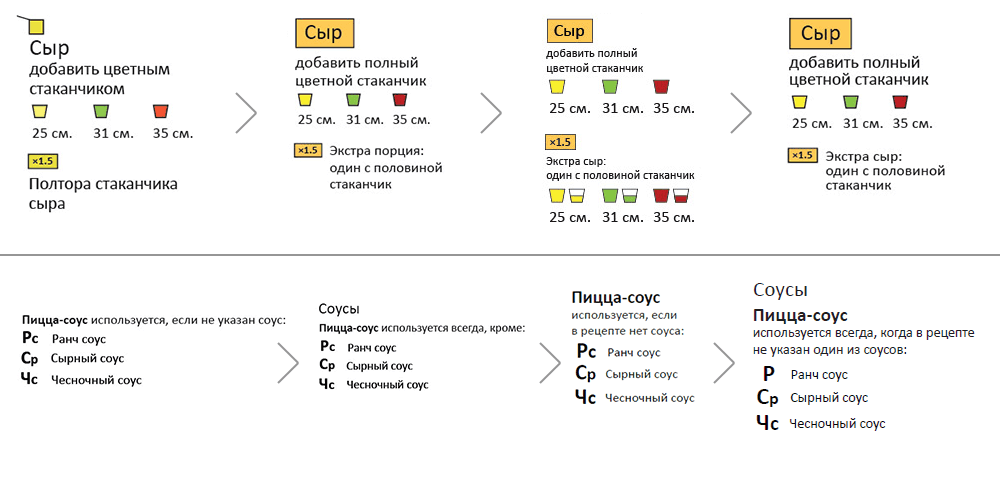
In the course of testing, the wording of some signatures was changed. A case in point: “one and a half cups” turns into “one and a half cups” after it turns out that not everyone immediately understands the meaning of the word “one and a half”.
The instruction was changed along with the stages of testing and in parallel with the changes in the schemes.
In the center of the scheme - a fictional pizza ("Chesn Barb") with a fictional recipe. The recipe includes all varieties of ingredients, and the name is not used in the present so that the pizza maker does not have the temptation to collect pizza according to this instruction.
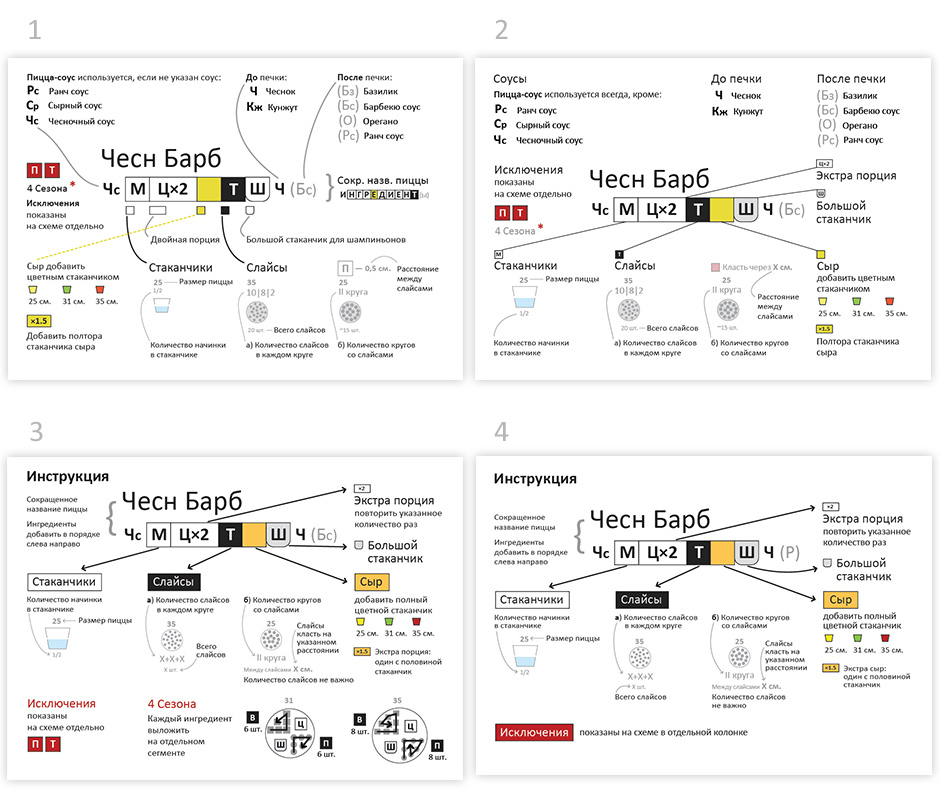
In addition to the edits according to the results of testing, the formats and sizes of the schemes changed - therefore some blocks migrated from the schemes to the instruction and vice versa. There was even a variant of combining instructions with the scheme on one large sheet.
For me, this project turned out to be the most intense in terms of the sources of feedback and external factors affecting the final result. I had to combine user testing sessions, processing test results and analyzing the decisions of the other participants in the recipe process. Such projects give invaluable experience. But even more pleased that the schemes are well remembered by employees and increase efficiency in the process of developing a network of pizzerias.
What else can you read on the topic
So, my task was to graphically depict pizza recipes, come up with universal schemes for the number of ingredients in each pizza, and the main thing is to make all this understandable for the average employee of the pizzeria.

One of the intermediate versions of a set of schemes for pizzerias. Schemes placed in this way were deployed on a monitor during testing before a volunteer. Today, in pizzerias, the ratio of the scale of the sizes of the schemes is different.
To understand the problem, I will give an example of the process of making Hawaiian pizza. If the name of this pizza is highlighted on the screen of the pizza player, he will find instructions on how to make it.

- Pizza Recipes Here you can find a list of ingredients of a particular product.
- Schemes of the number of ingredients. If an order is received for a medium-sized pizza (30 cm), then the pizza maker will pay attention to the blocks with the quantities for this pizza.
- Instructions. It exists to familiarize yourself with the principles of schemes. It shows what and how is encrypted.
')
The employee will add 15 pieces of ham slices in 3 circles, a double portion of pineapples (3/4 cups two times) and a standard portion of Mozzarella cheese for an average pizza (1 full green cup - the colors of the cups are not random, we have green boxes for medium pizzas) ).
The design has come a long way to the final version. Many of the change decisions are made as a result of testing on people who have never been to a pizzeria in the kitchen.
Simultaneously with the design of the schemes, the design of the instructions was also tested, which should have explained to the person the principle of the schemes themselves.
Testing
Testing has passed two stages.
At the first stage, I simply showed the results in the form of a PDF to managers and experienced employees of the pizzeria. Here we have identified the most obvious problems and difficulties.
At the second stage, I was looking for “people from the street,” that is, those who did not even work in a company, not like cooking pizza at a pizzeria. They were friends of acquaintances, office staff, casual visitors to a pizzeria, and even a course teacher for company managers. They showed the scheme, but I did not have access to the kitchen. I had to come up with a simulation.

"Layout" of the pizza assembly line on A4 paper
A computer with unfolded diagrams was placed in front of the subject, and an A4 sheet and several coins were placed on the table in front of him. I asked to comment out loud the process of reading the diagrams and watched how the person spreads the coin slices inside the drawn circle and what sequence different cups use.
After each stage of testing, I redraw the schema and start looking for new subjects for tests - retesting on the same people did not make much sense. It was possible to test the scheme on a few dozen people.
In details
Some of the details varied precisely because I saw difficulties in understanding the schemes of people. Then I will describe some of these changes - perhaps the information will be useful for someone.
Cups

An attempt to introduce an abstract designation of cups failed - the cup icon read better. For the bow, a suggestion was made to draw a pinch with a special icon. Here it is possible to trace how the placement of the signature changed with the number on the charts. As a result, all the inscriptions were centered.
Pizza Sizes

To avoid visual noise, it was planned to show columns with dimensions at the very top of the diagram. Due to difficulties in reading the diagrams, the sizes were duplicated for each block. You can also pay attention to how the blocks were separated from each other by rulers.
Abbreviations

It was originally planned to make a separate "legend" for the reduction of ingredients. But it turned out to be much more convenient to read the abbreviations combined with the transcripts. At first, the blocks of abbreviations had to be placed compactly in a limited space, but in the final version of the place it turned out to be allocated enough and all the abbreviations lined up in a column - it is easier to find and read them on the diagram.
Headlines

All the ingredients in the diagrams are divided into those that are put into cups and those that are put into slices (chopped by the ingredients). The headlines of the groups were first simply written in text, then there was an attempt to completely remove the headings, but in the end, the headings were decorated in the same style as the ingredients in the corresponding group.
Exceptions
It was immediately clear that all pizza recipes with the same amount of ingredients could not be adjusted - you need to provide for exceptions.

At first there were attempts to single out an exception with an asterisk in the recipe and, with an asterisk, to show the exception scheme under the normal scheme. But this is too imperceptible. Then the whole block of ingredient reduction-exception is highlighted in red background color. But in the quantity scheme there are attempts to somehow combine the normal quantity of the ingredient with the quantity in the exception (dashed line). As a result, all exceptions are placed in a separate column and receive the appropriate header.
Four seasons
A separate story with a pizza recipe Four seasons.

Slices of ham and pepperoni should be laid out with a “triangle”, and cups of champignons and chicken each in their own quarter pizza.
Slices and distances
One of the most difficult problems was to convey to the pizza maker the principle of slicing.
The fact is that the slices are laid out in two ways: individually (possibly with a different number of circles for different sizes of pizzas) or at a certain distance from each other (in this case it is not necessary to count the slices). Recipes-exceptions are often based on the second version of the layout.

At first, an approximate number of slices was indicated even in cases of exceptions (~ 15 and so on), but the person who noticed a specific number departed from the principle of calculation at a specified distance. For circles, it was decided to show the “guides”, otherwise the circles on the diagram were read poorly. In addition, it turned out that the amount of ingredient in each circle is better indicated by plus (“8 | 5 | 2” turned into “8 + 5 + 2”). It is also interesting to follow how the wording and design of the instruction about the distances between the slices changed.
Formulations

In the course of testing, the wording of some signatures was changed. A case in point: “one and a half cups” turns into “one and a half cups” after it turns out that not everyone immediately understands the meaning of the word “one and a half”.
Instruction
The instruction was changed along with the stages of testing and in parallel with the changes in the schemes.
In the center of the scheme - a fictional pizza ("Chesn Barb") with a fictional recipe. The recipe includes all varieties of ingredients, and the name is not used in the present so that the pizza maker does not have the temptation to collect pizza according to this instruction.

- The very first instruction turned out to be too "noisy." There was also an attempt to combine the instructions with the transcripts of some of the ingredients.
- Fewer shooters, simplification attempts.
- The cuts of the ingredients were gone (they moved to separate sheets with diagrams), an attempt to place here instructions for pizza Four seasons. Headings "Glass", "Slices" begin to repeat the design of the relevant ingredients.
- Final version. Minor edits. The heading "Exceptions" in the style of the other headers.
In addition to the edits according to the results of testing, the formats and sizes of the schemes changed - therefore some blocks migrated from the schemes to the instruction and vice versa. There was even a variant of combining instructions with the scheme on one large sheet.
Conclusion
For me, this project turned out to be the most intense in terms of the sources of feedback and external factors affecting the final result. I had to combine user testing sessions, processing test results and analyzing the decisions of the other participants in the recipe process. Such projects give invaluable experience. But even more pleased that the schemes are well remembered by employees and increase efficiency in the process of developing a network of pizzerias.
What else can you read on the topic
Source: https://habr.com/ru/post/196628/
All Articles